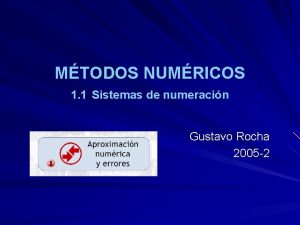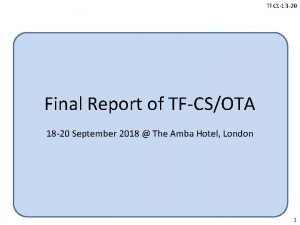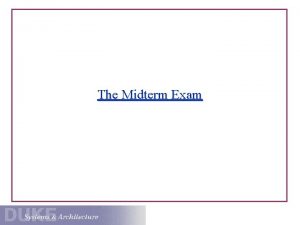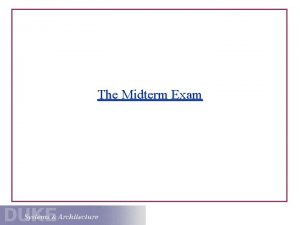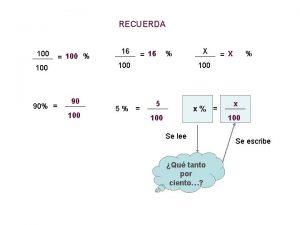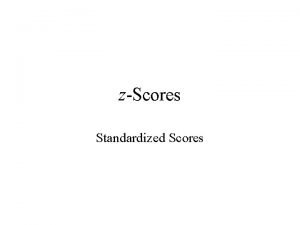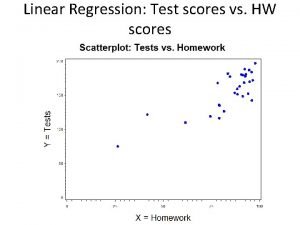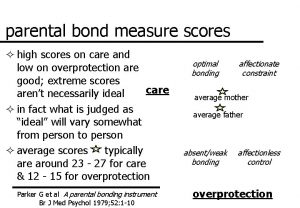SE 2811 Midterm Scores 100 90 80 70
















- Slides: 16

SE 2811 Midterm Scores 100 90 80 70 60 50 40 30 20 10 0 1 2 3 4 5 6 7 8 9 10 11 12 13 14 15 16 17 18 19 20 21 22 23 24 25 26 27 28 29 30 31 32 33 34 35 36 37 38 39 40 SE-2811 Dr. Mark L. Hornick 1

The Decorator Pattern SE-2811 Dr. Mark L. Hornick 2

Example: The “Ice Cream Store” Ice Cream #description What kind of a class is Ice Cream? +get. Description() +cost() Dish Cone cost() What kind of a method is cost? Why? cost() Waffle. Cone cost() Subclasses define their own implementation and return the cost of the Ice. Cream. 3

Decorator Pattern Intent You want to attach additional functionality to an (existing) class dynamically… l …without having to resort to sub-classing the existing class § l It’s also possible that the existing class is declared final, in which case you can’t subclass it …or making any modifications to the existing class § Also, you may not have access to the existing class’s source

The “Ice Cream Store” (contd. ) public abstract class Ice. Cream { String description; public String get. Description() { return description; } Ice Cream description public abstract double cost(); get. Description() cost() } public final class Cone extends Ice. Cream { Dish Cone cost() public Cone() { description = “Cone”; } public double cost() { return 1. 24; } cost() } 5

Extending functionality l Now in addition to your ice cream, you can also ask for additional toppings (Fudge, M&M’s, peanuts, …) l Charges are extra for each additional topping. l How should we design the system?

Alternative 1: Create a new class for each combination. Ice Cream Toppings Cone (abstract) M&M Dish Fudge Waffle. Cone Peanuts Caramel Any problems with this approach?

Alternative 1: Create a new class for each combination. Ice Cream Toppings Cone M&M Dish Fudge Waffle. Cone Peanuts Caramel • Results in class explosion! • Maintenance nightmare! • What happens when a new topping is added? • What happens when the cost of a topping (e. g. Fudge) changes? • What if a customer wants a combination of toppings?

Alternative 2: Using instance variables to keep track of the toppings? Ice. Cream -description: String -has. Fudge: boolean -has. Mn. M: boolean ------+get. Description() +cost() +has. Fudge() +has. Caramel() -----9

Alternative 2 (contd. ) public abstract class Ice. Cream { ……………… public double cost() { double topping. Cost = 0; if (has. Fudge()) { topping. Cost += oreo. Cost; } if (has. Caramel()) { topping. Cost += caramel. Cost; } …. return topping. Cost; } } 10

Alternative 2 (contd. ) public class Cone extends Ice. Cream { ……………… public double cost() { return 1. 24 + super. cost(); } } What is this method calculating and returning? 11

So what’s the problem? l l We want to allow existing classes to be easily adapted to incorporate new behavior without modifying existing code. We want a design that is flexible enough to take on new functionality to meet changing requirements. The Decorator Pattern comes to the rescue!!

SE-2811 Dr. Mark L. Hornick 13

SE-2811 Dr. Mark L. Hornick 14

Using the Decorator Pattern l Take the Ice. Cream object l l l Decorate it with the Fudge topping. l l l Create a Fudge object and wrap it around Cone. cone = new Fudge(); Decorate it with the Nuts topping. l l l Let’s create the Cone object. Ice. Cream cone= new Cone(); Create a Nuts object and wrap it around Cone. cone = new Nuts(cone); Call the cost method and rely on delegation to add the cost of all toppings. l l Call cost on the outmost decorator. System. out. println(cone. cost());

Summary l Decorators have the same super-type as the objects they decorate. l One or more decorators can be used to wrap an object. l Given that the decorator has the same super-type as the object it decorates, we can pass around a decorated object in place of the original (wrapped) object. l The decorator adds its own behavior either before and/or after delegating to the object it decorates to do the rest of the job. l Objects can be decorated at any time, so we can decorate objects at runtime with as many decorators as we like.
 100 100 100 100 100
100 100 100 100 100 Indexes scales and typologies
Indexes scales and typologies 1453-1337
1453-1337 C/100=f-32/180=k-273/100
C/100=f-32/180=k-273/100 200+200+100+100
200+200+100+100 100 + 200 300
100 + 200 300 100+100=200
100+100=200 What's 100 + 100
What's 100 + 100 100 men and 100 women took a test
100 men and 100 women took a test Big data on bare metal
Big data on bare metal 200+200+300
200+200+300 Malloc lab 100/100
Malloc lab 100/100 200+100+300
200+100+300 90 ın yüzde 10 u
90 ın yüzde 10 u Hexagesimal
Hexagesimal Grva midterm exam
Grva midterm exam Ap chemistry midterm review
Ap chemistry midterm review














